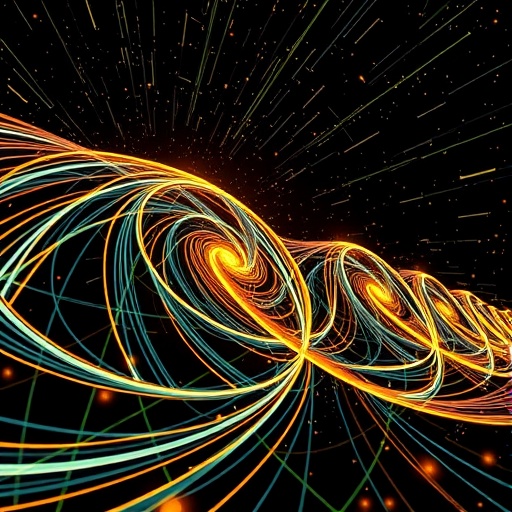In recent years, the field of gravitational-wave astronomy has undergone a monumental transformation, primarily propelled by the advancements in machine learning techniques. The advent of detectors like LIGO and Virgo has opened new frontiers in astrophysics, making it possible to identify and analyze events occurring in the universe with unparalleled precision. The study titled “Applications of Machine Learning in Gravitational-Wave Research with Current Interferometric Detectors,” authored by Cuoco, Cavaglià, Heng, and others, sheds light on the innovative intersection between artificial intelligence and gravitational-wave detection.
Machine learning serves as a significant catalyst in enhancing the capabilities of gravitational-wave detectors. The sheer volume of data generated by these detectors necessitates algorithms that can efficiently analyze it, revealing signals buried within overwhelming noise. The integration of machine learning techniques enables researchers to distinguish between genuine gravitational-wave signals and various foreground and background noise sources. This is critical, particularly as the number of detected events continues to rise, resulting in an exponential increase in data complexity.
The role of supervised learning techniques in gravitational-wave astrophysics cannot be overstated. By training algorithms on labeled datasets, scientists can develop models capable of identifying and characterizing gravitational-wave signals with high accuracy. This involves feeding the algorithms examples of known signals, allowing them to learn distinguishing features that can subsequently be applied to new, unseen data. As a result, the efficiency of identifying events, such as mergers of binary black holes or neutron stars, has significantly improved, changing the landscape of how observational astronomy is conducted.
Moreover, unsupervised learning methods play a crucial role in analyzing gravitational-wave data by detecting anomalous signals that have not yet been classified. These techniques utilize clustering and dimensionality reduction methods to explore data without requiring explicit labels, uncovering potentially interesting phenomena that would have otherwise gone unnoticed. This approach is particularly valuable given the ongoing discovery of new astrophysical objects, where our understanding of their characteristics is still developing.
Another significant application of machine learning lies in parameter estimation in gravitational-wave events. Accurately estimating parameters such as masses, spins, and the distance of the binary components involved in these events is essential for astrophysical insights. Traditional methods often rely on extensive calculations, requiring substantial computational resources. Machine learning systems can streamline this process, offering faster and often equally precise results, thus allowing scientists to focus on interpreting the implications of these observations rather than merely deriving the numbers.
In addition to enhancing analysis and parameter estimation, machine learning frameworks have also proven beneficial for the real-time detection of gravitational-wave signals. The immediacy of gravitational-wave astronomy requires that signals be recognized and classified swiftly to inform follow-up observations across other astronomical wavelengths, such as electromagnetic and neutrino observations. Machine learning models can be effectively employed in this real-time detection context, significantly reducing the latency between event occurrence and notification to the broader astrophysics community.
Collaboration between different astrophysical disciplines also stands to gain from machine learning applications. The techniques employed in gravitational-wave research can be adapted to analyze data from other astronomical missions, including those focused on cosmic microwave background radiation or galaxy formation. This interdisciplinary approach can foster robust methods that unify various aspects of research and lead to comprehensive insights into the universe’s workings.
The future of gravitational-wave astronomy appears promising as advancements in machine learning continue to unfold. As researchers refine existing algorithms and develop new techniques, our understanding of cosmic events will become even more nuanced. This continual improvement could lead to the discovery of novel astrophysical phenomena, providing answers to long-standing questions such as the origins of black holes and the nature of dark energy.
Nevertheless, the integration of machine learning and gravitational-wave research is not without its challenges. Concerns regarding data quality, model interpretability, and the need for robust validation methods persist. It is essential for the scientific community to address these challenges responsibly, ensuring that the interpretations of results derived from machine learning techniques are accurate and reliable. This vigilance will be paramount for maintaining public trust in scientific findings characterized by data-driven methodologies.
Further research is required to optimize the algorithms used in gravitational-wave detection and to implement them in a way that accounts for the erratic nature of the astronomical signals encountered. Collaborative projects and sharing of techniques across institutions can facilitate the development of more sophisticated methods. The commitment to innovation in this field will undoubtedly continue to drive the science of gravitational-wave astronomy forward.
As we stand on the cusp of what may very well be a new era in astrophysics, it is clear that the synergy between machine learning and gravitational-wave research is poised to redefine the boundaries of our understanding of the universe. The prospect of uncovering more profound truths about the cosmos excites both scientists and enthusiasts alike. In the coming years, as the sophistication of these models increases, we anticipate an acceleration in our capacity to observe, analyze, and interpret the symphony of gravitational waves echoing throughout the fabric of spacetime.
This intersection of technology and research exemplifies a profound evolution in scientific inquiry – an evolution that opens new paths of discovery and challenges our existing paradigms. With every signal detected, we not only broaden our knowledge of the universe but also deepen our appreciation for the complex interplay of phenomena that underpins the cosmos. Gravitational-wave astronomy, empowered by machine learning, promises to remain on the frontier of astronomical exploration—rich with potential insights waiting to be uncovered.
Subject of Research: Applications of machine learning in gravitational-wave research
Article Title: Applications of machine learning in gravitational-wave research with current interferometric detectors
Article References:
Cuoco, E., Cavaglià, M., Heng, I.S. et al. Applications of machine learning in gravitational-wave research with current interferometric detectors.
Living Rev Relativ 28, 2 (2025). https://doi.org/10.1007/s41114-024-00055-8
Image Credits: AI Generated
DOI:
Keywords: Machine Learning, Gravitational Waves, Astrophysics, Data Analysis, LIGO, Virgo, Parameter Estimation, Real-Time Detection




